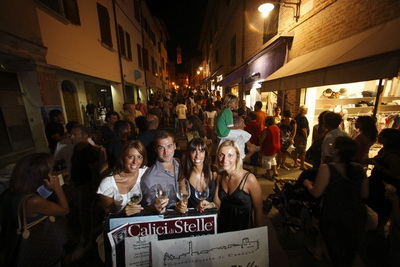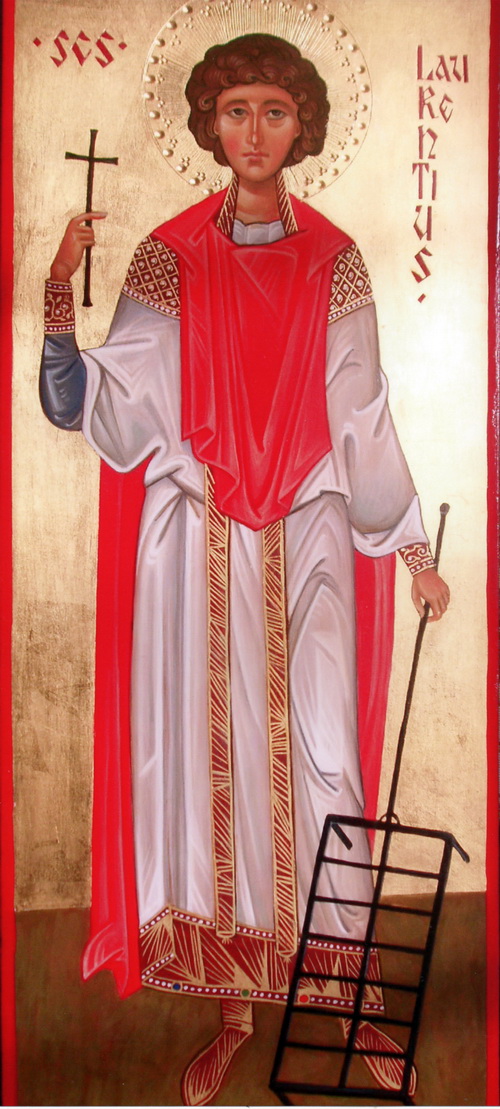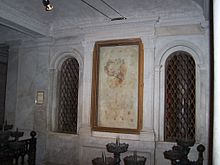Новости Италии > Ночь Сан-Лоренцо – когда сбываются мечты итальянцев
Если у вас есть мечта (или несколько), то ночью 10 августа вам нельзя будет сидеть дома, а следует обязательно провести это время под открытым небом, в котором вы можете увидеть знаменитые слезы Сан-Лоренцо. В это свято верят итальянцы, которые в ночь святого Лоренцо (notte di San Lorenzo) собираются веселыми компаниями на пляжах, лужайках, пригорках — словом, везде, откуда можно свободно наблюдать падающие с неба звезды — слезы святого.
10, 11 и 12 августа комета 109P/Swift-Tuttle теряет свои частицы, и когда Земля проходит через облака этих крошек, они попадают в нашу атмосферу и сгорают в ней. Явление, которое можно наблюдать невооруженным глазом — это дождь падающих звезд, или, как предпочитают его называть итальянцы: поток слез Сан-Лоренцо.
Это явление относится не только к комете, но и к святому, который умер мученической смертью 10 августа 258 года в Риме. Он был подвергнут жестоким пыткам, в ходе которых, как гласит традиция, плакал над грехами мира. Сегодня св. Лоренцо является покровителем всех людей, кто имеет дело с высокой температурой – как получивших ожег по неосторожности, так и специалистов — пожарных, металлургов, кочегаров, поваров и пекарей. Святой этот также защищает всех от пламени ада.
Лоренцо был одним из семи дьяконов в Риме и отвечал за финансы и опеку над бедными. Он отказал императору Валериану, посягнувшему на имущество церкви, и за это был осужден на пытки и казнь на Via Tiburtina в Риме.
В очень короткий срок Лоренцо стал одним из самых почитаемых святых. Над его могилой император Константин построил в 330 году церковь. Его культ распространился по всей Европе после победы императора Отто I над венграми в день св. Лаврентия в 955 году. Самая ценная реликвия, голова святого, находится в Ватикане.
Что нужно сделать, чтобы падающие звезды реализовали 10 августа наши мечты?
Просто смотреть на звезды недостаточно. Нужно загадать желание, проговорив волшебную фразу: «Stella, mia bella stella desidero che…» (Звезда, моя прекрасная звезда, я желаю себе, чтобы…) и рассказать о своем желании. На каждую падающую звезду полагается одно желание – но в эту ночь их будет падать много, поэтому можно заранее «запастись» желаниями.
Поскольку больше всего падающих звезд наблюдается во второй половине ночи и утром, итальянцы в ночь Сан-Лоренцо часто вообще не ложатся спать.
В Италии каждый город имеет своего святого покровителя. Св. Лоренцо является покровителем более 200 итальянских городов в Италии! Для жителей города, которые имеют покровителем Сан-Лоренцо — это праздник города, день, свободный от работы.
Новости Италии | Добавлена: 02.08.2016 в 10:45 | Просмотров: 4016 | Комментариев: 0
Пока что нет ни одного комментария к этой публикации. Будь первым!
РЕГИСТРАЦИЯ занимает всего 1 минуту и введена с целью облегчить и ускорить работу пользователей.
Зарегистрировавшись на сайте, Вы получаете массу преимуществ:
1. Вам не нужно будет каждый раз писать свое имя при комментировании публикаций.
2. Уведомление об ответе в разделе Юридическая консультация прийдет на Ваш E-mail.
3. Вы сможете подписаться на любимые темы и следить за их развитием.
4. Вы сможете участвовать в конкурсах и получать призы.
5. Вы сможете переписываться с другими участниками сайта.
6. Вы получите доступ к закрытым ресурсам сайта.
И многое другое. Станьте участником нашего клуба, нажимайте РЕГИСТРАЦИЯ.

Ответ на этот вопрос лежит на стыке астрономии, истории и религии. Более того, именно в эту ночь при наблюдении за звездами принято загадывать желания. Говорят, у многих они сбываются.
С точки зрения астрономии
Ночь с 10 на 11 августа известна как «ночь падающих звезд». Дело в том, что обычно в этот период и последующие двое суток Земля проходит через траекторию полета кометы Свифта-Таттла. От неё идет метеорный поток Персеиды. Метеоры, частицы метеоритов, попадая в атмосферу земли, воспламеняются и сгорают, напоминая дождь из падающих звезд.
Страницы истории
Почему итальянцы называют падающие звезды «слезами Сан Лоренцо»? Давайте совершим небольшой экскурс в историю Древнего Рима.
Святой Лаврентий был одним из архидиаконов христианской общины в Риме. Он вступил в спор с императором Валерианом, когда тот претендовал на имущество церкви. По преданию, Лоренцо был осужден и заживо сожжен на железной решетке 10 августа 258 года.
В народной традиции падающие звезды также часто называют «огнями святого Лоренцо». Считается, что они напоминают искры, вылетавшие из-под решетки, на которой сжигали святого.
Кстати, …
…поскольку святой Лоренцо был сожжен на костре, его считают покровителем «огненных» профессий — кочегаров, пожарных, металлургов и даже пекарей.
Загадываем желание
Итальянцы считают, что в ночь с 10 на 11 августа нужно не просто смотреть на звездопад. Главное — загадать желание. А для этого необходимо произнести волшебную фразу: «Stella, mia bella stella desidero che…» и озвучить своё желание.
Говорят, что одна падающая звезда исполняет одно желание. Поскольку звёзд в эту ночь падает много, рекомендуют заранее вспомнить или даже записать все свои желаниями.
_____________________________
Разумеется, ночь Сан Лоренцо нашла отражение в итальянской культуре. Предлагаю послушать невероятно душевную песню «Notte di San Lorenzo» в исполнении Клаудио Санфилиппо, Франческо Саверио Порчиелло и Эудженио Финарди (Claudio Sanfilippo, Francesco Saverio Porciello, Eugenio Finardi).
Если на вашем устройстве видео не воспроизводится, вы можете посмотреть его по ссылке: https://www.youtube.com/watch?time_continue=147&v=AGRatl5BJzk&feature=emb_logo
Загадывайте желания — и они обязательно сбудутся!
© Татьяна Трунова, август 2020
Статьи о других астрономических явлениях
- Eclissi — в очерке дается этимология слова, рассказывается о том, как называются разные виды затмений и что означает глагол «eclissarsi» как в прямом, так и в переносном смысле
- Solstizio d’estate — в очерке приводится этимология выражения «летнее солнцестояние», а также рассказывается об одной архитектурной достопримечательности, которая связана с этим астрономическим явлением
Выражения с именами итальянских святых
- L’estate di San Martino — что представляет собой «лето святого Мартина» и почему оно выпадает на осень
- «Andare con il cavallo di San Francesco» — этимология и значение выражения, а также фото одного забавного указателя в Ассизи
Приготовьтесь любоваться падающими звездами и загадывать желания, потому что, как и каждый год, наступает ночь Сан-Лоренцо в Италии. Italian Traditions расскажет вам об одной из самых волшебных ночей в году.
Ночь Сан-Лоренцо в Италии: между астрономией и традицией
Наука
Ночь Сан-Лоренцо в Италии приходится на 10 августа, но зрелище длится несколько дней, примерно до 13 числа месяца. Период определяется циклическим прохождением кометы Свифта-Туттля и ее следа из обломков — метеорного потока Персеид, который встречается на орбите Земли. Особенностью этой кометы является ее большой размер, поэтому она порождает множество метеороидов. Фрагменты пыли и льда входят в атмосферу Земли на очень большой скорости, создавая впечатляющие световые следы, известные как «падающие звезды».
История
Впервые наблюдаемые в 36 году нашей эры, Персеиды также известны как «слезы Сан-Лоренцо». Именно 10 августа 158 года нашей эры произошла мученическая смерть Сан-Лоренцо. Указ римского императора Валериана предписывал преследовать епископов и пресвитеров вплоть до их убийства, поэтому архидиакон был сожжен заживо. Легенда допускает два толкования: в первом случае падающие звезды представляют собой слезы, пролитые святым во время его мученической смерти, во втором — горящие угли.
Традиция
Согласно народной традиции, в ночь Сан-Лоренцо каждый, кто вспомнит о скорби святого и загадает желание, глядя на падающие звезды, увидит, как его желание исполнится. С древних времен звезды интерпретировались как символы божественных проявлений, хороших или плохих предзнаменований, и по этой причине они всегда были связаны с исполнением желаний. До 17 века астрономию называли астрологией: гороскоп указывает на судьбу, написанную на звездах. Еще одно возможное происхождение этой традиции можно найти в «De bello Gallico», работе Юлия Цезаря, в которой он рассказывает о завоевании Галлии: «desiderantes» были солдатами, чьей задачей было стоять ночью на страже и ждать спасения своих товарищей, участвующих в сражении, возвращения которых они страстно желали.
Мероприятия
По всей Италии в ночь на Сан-Лоренцо проходят торжественные мероприятия и фестивали, посвященные звездной ночи. Один из самых известных повторяющихся праздников проходит в городе Амасено (Amaseno), в провинции Фрозиноне: в церкви Санта-Мария-Ассунта, где хранится реликвия с кровью святого, проводится очень интересная религиозная церемония. Во Флоренции, где Сан-Лоренцо является святым покровителем города, каждый год проводятся празднования, включающие шествие к базилике, посвященной святому, и ужин на площади с музыкой. Еще одним популярным событием является мероприятие «Кубки звезд» (Calici di Stelle), в котором принимают участие многие итальянские площади и винодельни; в течение вечера организуются дегустации вин и типичных местных продуктов. На пляжах Червии (Cervia) пляжные заведения развлекают до поздней ночи банкетами, музыкой и грандиозным шоу фейерверков.
Для тех, кто предпочитает тишину и покой, и хочет иметь идеальный вид на небо, наилучшим вариантом будет выезд за пределы населенных центров, чтобы искусственное освещение не мешало, и вы могли в полной мере насладиться зрелищем падающих звезд на фоне природы.
La Notte di San Lorenzo

Лоренцо был одним из семи дьяконов древнего Рима, которые были подвергнуты мучительным пыткам и религиозным преследованиям по приказу римского императора Валериана в 258 году. Во время его правления было запрещено устраивать собрания и встречи христианских верующих, а также проявлять неуважение к обрядам и традициям язычников. Множество священников и епископов были приговорены к смерти, а христиане, имеющие отношение к дворянству или к парламенту, были лишены своего имущества и высланы. Святой Лоренцо тесно сотрудничал с Папой Сикстом II, первым пострадавшим от гонений императора, помогал ему при подготовке к различным обрядам, был ответственным за имущество церкви, а также заботился о малоимущих. После казни Папы римский префект потребовал у Лоренцо отдать государству сокровища Церкви. Попросив три дня срока, архидиакон раздал почти всё церковное имущество беднякам. На третий день он явился к префекту вместе с толпой нищих, калек, слепых и больных, заявив: «Вот подлинные сокровища Церкви». За эти слова Лоренцо был подвергнут жестоким пыткам и, отказавшись поклониться языческим богам, казнен.
В Ночи Святого Лоренцо смешалось христианское и языческое, рациональное и мистическое, потому что вера в чудо и в возможность исполнения мечты была свойственна людям во все времена. Вот почему в эту волшебную ночь все стараются разглядеть на ночном небе падающую звезду и в краткий миг ее падения успеть загадать желание. Считается, что желание, загаданное в Ночь Святого Лоренцо непременно исполнится в самое ближайшее время. Увидев падающую звезду нужно сказать : «Звезда, моя звездочка, желаю чтобы…» («Stella, mia bella stella, desidero che…») , а затем поверить в то, что все будет так, как хочется тебе. И желание обязательно исполнится!

«Звездные бокалы» — традиционное летнее событие, организатором которого выступает «Движение винного туризма». Дегустации вин и продуктов местной кухни проходят под руководством опытных сомелье и известных энологов и всегда сопровождаются концертами джазовой и классической музыки, историческими шествиями, театральными представлениями и пиротехническими зрелищами.

В Романье существует поверье, что в Ночь Сан Лоренцо нужно семь раз погрузиться в воду, чтобы смыть с себя все плохое и привлечь удачу и счастье. С незапамятных времен толпы желающих приобщиться к чуду стремятся к морю, которое должно избавить их от болезней и проблем.В Агридженто на Сицилии считают, что «охота за падающими звездами» особенно прекрасна в компании с поэзией. В Пьемонте полагают, что нет ничего лучше, чем воскресить в театральных постановках и застольях античные традиции. Миланцы в эту ночь наслаждаются классической музыкой, а в провинции Комо устраивают ужин при свечах и ночную прогулку, во время которой участники получают возможность узнать больше о созвездиях и о легендах, связанных с ними.

Традиции, астрономия, история, волшебство — все смешалось в этой особенной августовской ночи. Дети и взрослые, которые в это время снова становятся детьми, доверяют ночному небу свои надежды, мечты и желания, веря в то, что все возможно и все может случиться. Небо, такое далекое и загадочное, в Ночь Святого Лоренцо позволяет нам поразмышлять, вернуться в прошлое, влюбиться и поверить в ответную любовь, вспомнить тех, кого уже нет с нами, пожелать добра тем, кто рядом, помечтать и поверить в сказку. Что может быть лучше, чем лежать на душистой траве под летним небосводом, усыпанным сверкающими звездами, слушать музыку Космоса и мечтать о чуде!
-
-
August 8 2021, 16:29
- Религия
- Общество
- Cancel
Легенда ночи Сан-Лоренцо
Ночами около 10 августа небо обычно пересекает ливень из небольших метеоров, которые кажутся нашим глазам традиционными падающими звездами.
Ночью 10 августа в католической традиции принято поминать Сан-Лоренцо, и вот что гласит легенда.
В Италии падающие звёзды легко наблюдать, в том числе благодаря летнему сезону, который гарантирует чистое небо и приятную температуру, когда комфортно оставаться на открытом воздухе. Это явление было известно с древности, и падающие звезды считались важным предзнаменованием. В Риме 10 августа выпадало на праздник, посвященный богу Приапу, богу мужского плодородия.
С приходом христианства многие римские традиции были сохранены, но преобразованы в новой религии. То же произошло и с праздником 10 августа. Падающие звёзды идентифицировались теперь не с мифом о Приапе, а с Сан Лоренцо — Святым Лаврентием. Он принял мученическую смерть в 258 году, когда развернулись широкомасштабные гонения на христиан. Несколькими днями ранее папа Сикст II и некоторые из его дьяконов были убиты обезглавливанием, а 10 августа настала очередь Лоренцо, которому на тот момент было 33 года. По словам Сант’Амброджо, Лоренцо был сожжён на раскаленной решётке, подогреваемой тлеющими углями. Скорее всего, согласно исследованиям современных историков, в этом преследовании доминировали казни, а не пытки, поэтому весьма вероятно, что Лоренцо тоже просто обезглавили.
Что бы ни случилось на самом деле, впечатляющее мученичество святого Лаврентия на расклённой решётке вошло в христианскую традицию, вдохновив многие произведения искусства. Память о мученической кончине Сан-Лоренцо отмечается 10 августа. Падающие звёзды, которые можно видеть ночью, объявляются слезами святого во время пыток и превращенные в звезды для напоминания о страданиях. Иногда рассказывают про раскаленные угли, которыми нагревали решётку, на которой находился мученик.
По традиции, увидеть падающую звезду будет хорошим предзнаменованием и позволит исполнить загаданное во время падения желание.
From Wikipedia, the free encyclopedia
This article is about the 3rd-century Christian martyr. For other people or places called Saint Lawrence, see Saint Lawrence (disambiguation).
|
Saint Lawrence |
|
|---|---|

Lawrence before Valerian, detail from a fresco by Bl. Fra Angelico, c. 1447–50, Pinacoteca Vaticana |
|
| Martyr | |
| Born | 31 December AD 225[1] Huesca[2] or less likely Valencia, Hispania (modern-day Spain) |
| Died | 10 August AD 258 (aged 32) Rome |
| Venerated in | Roman Catholic Church Eastern Orthodoxy Anglican Communion Lutheranism |
| Canonized | Pre-congregation |
| Major shrine | Basilica di San Lorenzo fuori le Mura in Rome |
| Feast | 10 August |
| Attributes | Usually holding a gridiron and wearing a dalmatic |
| Patronage | Rome, Grosseto, Rotterdam (Netherlands), Huesca (Spain), San Lawrenz, Gozo and Birgu (Malta), Barangay San Lorenzo San Pablo (Philippines), Canada, Colombo City, comedians, archivists, librarians, students, miners, tanners, chefs, Balagtas, Bulacan, Balangiga, Eastern Samar, Mexico, Pampanga, San Lorenzo Diakono Chapel, Mexico, Pampanga, roasters, poor, firefighters |
Saint Lawrence or Laurence (Latin: Laurentius, lit. «laurelled»; 31 December AD 225[1] – 10 August 258) was one of the seven deacons of the city of Rome under Pope Sixtus II who were martyred in the persecution of the Christians that the Roman Emperor Valerian ordered in 258.
Life[edit]
St. Lawrence is thought to have been born on 31 December AD 225,[1] in Valencia (or less probably, in Huesca), the town from which his parents came in the later region of Aragon that was then part of the Roman province of Hispania Tarraconensis.[2] The martyrs Orentius (Modern Spanish: San Orencio) and Patientia (Modern Spanish: Santa Paciencia) are traditionally held to have been his parents.[3][4]
Lawrence encountered the future Pope Sixtus II, a famous teacher born in Greece, in Caesaraugusta (Zaragoza), and they travelled together from Spain to Rome. When Sixtus became the Pope in 257, he ordained the young Lawrence who was only 22, as a deacon, and later and appointed him as «archdeacon of Rome», the first among the seven deacons who served in the cathedral church. This was a position of great trust that included the care of the treasury and riches of the Church and the distribution of alms to the indigent.[5]
St. Cyprian, Bishop of Carthage, noted that the at the time, the norm was that Christians who were denounced were executed, and all their goods confiscated by the Imperial treasury. At the beginning of August 258, the Emperor Valerian issued an edict that all bishops, priests, and deacons should immediately be put to death. Pope Sixtus II was captured on 6 August 258, at the cemetery of St. Callixtus while celebrating the liturgy and executed immediately.[6]
After the death of Sixtus, the prefect of Rome demanded that Lawrence turn over the riches of the Church, and St. Ambrose wrote that Lawrence asked for three days to gather the wealth.[7], distribute as much Church property to the poor, presented himself and the city’s poor to the Prefect as the true wealth of the church, and was martyred on the 10th. [8]
Martyrdom[edit]
The Martyrdom of Saint Lawrence by Rubens (1614).
As a deacon in Rome, Lawrence was responsible for the material goods of the Church and the distribution of alms to the poor.[8] Ambrose of Milan related that when the treasures of the Church were demanded of Lawrence by the prefect of Rome, he brought forward the poor, to whom he had distributed the treasure as alms.[9] «Behold in these poor persons the treasures which I promised to show you; to which I will add pearls and precious stones, those widows and consecrated virgins, which are the Church’s crown.»[5] The prefect was so angry that he had a great gridiron prepared with hot coals beneath it and had Lawrence placed on it, hence Lawrence’s association with the gridiron. After the martyr had suffered pain for a long time, the legend concludes, he cheerfully declared: «I’m well done on this side. Turn me over!»[8][10] From this, St. Lawrence derives his patronage of cooks, chefs, and comedians.
Lawrence was sentenced at San Lorenzo in Miranda and imprisoned in San Lorenzo in Fonte, where he baptized fellow prisoners. He was martyred in San Lorenzo in Panisperna, and was buried in San Lorenzo fuori le Mura. The Almanac of Filocalus for 354 states that he was buried in the Catacomb of Cyriaca on the Via Tiburtina[9] by Hippolytus and Justin the Confessor, a presbyter. One of the early sources for his martyrdom was the description of Aurelius Prudentius Clemens in his Peristephanon, Hymn 2.
Despite the Church being in possession of the actual gridiron, historian Patrick J. Healy opines that the traditional account of how Lawrence was martyred is «not worthy of credence,»[11][page needed] as the slow, lingering death cannot be reconciled «with the express command contained in the edict regarding bishops, priests, and deacons (animadvertantur) which ordinarily meant decapitation.»[11][page needed] A theory of how the tradition arose is proposed that as the result of a mistake in transcription, the omission of the letter «p» – «by which the customary and solemn formula for announcing the death of a martyr – passus est [«he suffered,» that is, was martyred] – was made to read assus est [he was roasted].»[11][page needed] The Liber Pontificalis, which is held to draw from sources independent of the existing traditions and Acta regarding Lawrence, uses passus est concerning him, the same term it uses for Pope Sixtus II, who was martyred by decapitation during the same persecution 4 days earlier.[11][page needed]
Emperor Constantine I is held to have erected a small oratory in honour of Lawrence, which was a station on the itineraries of the graves of the Roman martyrs by the seventh century. Pope Damasus I rebuilt or repaired the church, now the Basilica di San Lorenzo fuori le Mura, while the Minor Basilica of San Lorenzo in Panisperna was erected over the site of his martyrdom. The gridiron of the martyrdom was placed by Pope Paschal II in the Minor Basilica of San Lorenzo in Lucina.[citation needed]
Associated Roman churches[edit]
St. Lawrence in stained glass window by Franz Mayer & Co. He is holding a palm branch, a symbol of martyrdom, and a griddle, the instrument of his death.
The Roman Catholic Church erected six churches on the sites in Rome traditionally associated with his martyrdom:
- Minor Basilica of St Lawrence in Damaso (Basilica Minore di San Lorenzo in Damaso): site where he performed his duties as deacon of Rome;
- Minor Basilica of St Mary in Domnica alla Navicella (Basilica Minore di Santa Maria in Domnica alla Navicella): site where he customarily distributed alms to the indigent;
- Annexed Church of St Lawrence in Miranda (Chiesa Annessa San Lorenzo de’ Speziali in Miranda): site of his sentencing and condemnation by the Prefect of Rome;
- Annexed Church of St Lawrence in Fonte (Chiesa Annessa San Lorenzo in Fonte): site of his imprisonment by the centurion Ippolito and of the fountain in which the Saint baptized his fellow prisoners;
- Church of St Lawrence in Panisperna (Chiesa di San Lorenzo in Panisperna): site of his actual martyrdom/death and the oven used to roast him to death; and
- Papal Minor Basilica of St Lawrence outside the Walls (Basilica Minore Papale di San Lorenzo fuori le Mura: site of his burial and sepulchre.
Also in Rome are three other significant churches that are dedicated to Saint Lawrence but not associated with his life:
- Minor Basilica of St Lawrence in Lucina (Basilica Minore di San Lorenzo in Lucina), which possesses the relics of the gridiron on which and the chains with which he was martyred;[12]
- Church of St. Lawrence in Palatio ad Sancta Sanctorum, Pontifical Sanctuary of the Holy Stairs (Chiesa di San Lorenzo in Palatio ad Sancta Sanctorum, Pontificio Santuario della Scala Santa), proximate to the Archbasilica of St. John in Laterano, which was originally a private Papal chapel when the edifice that houses it was a Papal palace, and which housed some of the most precious relics of the Roman Catholic Church, hence the title «Sancta Sanctorum» («Holy of Holies»); and
- Church of St Lawrence in Piscibus (Chiesa di San Lorenzo in Piscibus), which is proximate to the Basilica of St. Peter
Miracles[edit]
The life and miracles of Lawrence were collected in The Acts of St Lawrence but those writings have been lost. The earliest existing documentation of miracles associated with him is in the writings of Gregory of Tours (538–594), who mentions the following:
A priest named Fr. Sanctulus was rebuilding a church of St. Lawrence, which had been attacked and burnt, and hired many workmen to accomplish the job. At one point during the construction, he found himself with nothing to feed them. He prayed to St. Lawrence for help, and looking in his basket he found a fresh, white loaf of bread. It seemed to him too small to feed the workmen, but in faith he began to serve it to the men. While he broke the bread, it so multiplied that his workmen fed from it for ten days.[5][better source needed]
The mediaeval Church of St Mary Assumed (Chiesa di Santa Maria Assunta) in the small commune of Amaseno, Lazio, Italy houses the famous reliquary of the ampulla containing relics of Lawrence, namely a quantum of his blood, a fragment of his flesh, some fat and ashes. Tradition holds that annually, on the Feast of St. Lawrence, and sometimes on other occasions, the blood in the ampulla miraculously liquefies during the Feast and re-coagulates by the following day.[13][better source needed]
Veneration[edit]
Due to his conspiring to hide and protect the written documents of the Church, Lawrence is known as the patron saint of archivists and librarians.[14]
Roman Catholic Church[edit]
Lawrence is one of the most widely venerated saints of the Roman Catholic Church. Legendary details of his death were known to Damasus, Prudentius, Ambrose, and Augustine. Devotion to him was widespread by the fourth century. His liturgical celebration on 10 August has the rank of feast in the General Roman Calendar, consistent with the oldest of Christian calendars, e. g. the Almanac of Philocalus for the year 354, the inventory of which contains the principal feasts of the Roman martyrs of the middle of the fourth century. He remains one of the saints enumerated in the «Roman Canon» of the Holy Mass as celebrated in the Latin Church.[citation needed]
Lawrence is especially honoured in the city of Rome, of which he is considered the third patron after St. Peter and St. Paul.[15] The church built over his tomb, the Papal Minor Basilica di San Lorenzo fuori le Mura, became one of the seven principal churches of Rome and a favourite place of Roman pilgrimages.[10] The area proximate to the Basilica di San Lorenzo fuori le Mura is named the «Quartiere San Lorenzo».[citation needed]
Because the Perseid Meteor Shower typically occurs annually in mid-August on or proximate to his feast day, some refer to the shower as the «Tears of St Lawrence».[5]
His intercession to God is invoked by librarians, archivists, comedians, cooks and tanners as their patron. He is the patron saint of Ampleforth Abbey, whose Benedictine monks founded one of the world’s leading public schools for Catholics, located in North Yorkshire (North East England).[citation needed]
On his feast the reliquary containing his burnt head is displayed in the St. Peter’s Basilica for veneration.[citation needed]
Anglican Communion[edit]
Within Anglicanism Lawrence’s name is traditionally spelled Laurence or Lawrence. His feast is on 10 August which is in the calendar of the Book of Common Prayer, the volume of prayers which, in its 1662 format, was the founding liturgical document of a majority of Anglican provinces. In the Book of Common Prayer the feast is titled «S Laurence, Archdeacon of Rome and Martyr». His feast on 10 August has been carried into the contemporary calendars of most Anglican provinces,[16] Laurence is remembered in the Church of England[17] with a Lesser Festival under the title «Laurence, deacon, martyr, 258» on 10 August.[18]
Anglo-Catholics venerate Lawrence, who is the patron of many Anglican parish churches, including 228 in England.[19][20] A major church in Sydney, Australia, in the former civil parish of St Laurence, is known as «Christ Church St Laurence». The Anglican charitable society, Brotherhood of St Laurence also bears his name.[citation needed]
Legacy[edit]
According to Francesco Moraglia the role of deacon is distinguished by service of the poor. He is destined both to the service of the table (corporal works of mercy) and to the service of the word (spiritual works of mercy). «The beauty, power and the heroism of [d]eacons such as Lawrence help to discover and come to a deeper meaning of the special nature of the diaconal ministry.»[6]
El Escorial, near Madrid, laid out in a grid pattern resembling a gridiron.
Many churches, schools, parishes, towns, and geographic features throughout the world are named for Lawrence of Rome. Depending on locality they are named St. Lawrence, St. Laurence, San Lorenzo, St. Laurent, St. Lorenz or similarly in other languages. San Lorenzo del Escorial, the monastery built by King Philip II of Spain, commemorates his victory at the Battle of St. Quentin (1557) on the Feast of St. Lawrence.[21] The monastery and the attached palace, college, and library are laid out in a grid pattern that resembles the gridiron of Lawrence’s martyrdom. The gridiron of Lawrence is also thought the basis of the design of the Certosa di San Lorenzo di Padula, which is a monastery in Padula, Salerno, Italy. Two universities bear his name: St. Lawrence University (non-Catholic) in Canton, St. Lawrence County, New York, United States, and St. Lawrence University in Kampala, Uganda. There is a school named after him in Kolkata named St.Lawrence High School,Kolkata.
Canada’s patron saint is St. Lawrence. On his second voyage, French explorer Jacques Cartier, arriving in the river estuary of the North American Great Lakes on the Feast of St. Lawrence in 1535, named it the Gulf of St. Lawrence.[22]
The river emptying into the gulf was named the St. Lawrence River. Many names in what are now Québec and the Maritime Provinces of Canada are references to this important seaway, e. g., the Laurentian mountains north of the city of Montreal, Saint-Laurent (borough), Saint Lawrence Boulevard which spans the width of the Island of Montreal, and St. Lawrence County, New York, United States near Lake Ontario.
In the province of Ontario, St. Lawrence is a prominent, historic neighbourhood in old centre of Toronto (formerly named York), now most known for the expansive St. Lawrence Market. The Laurentian Mountains gave rise to the name for the Laurential Plateau, or the Canadian Shield. In Switzerland, Saint Lawrence is represented on the coat of arms of the city of Bülach with a gridiron.
The rescue operation for the miners trapped in the 2010 Copiapó mining accident in Chile was named Operacíon San Lorenzo after Lawrence, patron saint of miners.[23]
In Freemasonry the Order of St. Lawrence the Martyr is a masonic degree whose ritual is based upon the story of Lawrence. It is one of the constituent degrees of the Allied Masonic Degrees.
Bernalillo, New Mexico celebrates three days of devotions to the Saint, in honor a devotional promise made by Spanish settlers during the 1692 Pueblo Revolt. Among the festivities are a set of dances performed by matachines. An image of the saint is kept in the house of a local family throughout the year, and a vigil and feast are held from 9–11 August. It is one of the oldest dancing processions in the New World.[24]
Patronage[edit]
- Against Fire
- Against Lumbago
- Archives and Archivists
- Armouries and Armourers
- Barbecues
- Brewers
- Butchers
- Comedians
- Cooks, chefs and restaurant owners
- Cutlers
- Deacons
- Glaziers and stained glass workers
- Laundry workers
- Libraries and librarians
- Miners
- Paupers and poor people
- Seminarians
- Students
- Tanners
- Viticulturists, wine makers and wine sellers
- Abano Terme, Italy
- Alba, Italy
- Angrogna, Italy
- Bernalillo, New Mexico, USA
- Berzo Demo, Italy
- Berzo Inferiore, Italy
- Brissogne, Italy
- Cabella Ligure, Italy
- Camino, Italy
- Canada
- Cavatore, Italy
- Chambave, Italy
- Denice, Italy
- Esbonderup, Denmark
- Folgaria, Italy
- Gamalero, Italy
- Gross Gartach, Germany
- Győrszemere, Hungary
- Huesca, Spain
- Il-Birgu, Malta
- Ilaya, Dapitan City, Philippines
- Limbazi, Latvia
- Lund, Sweden
- Montevarchi, Italy
- Mortara, Italy
- Naurod, Germany
- Oldenburg, Lower Saxony, Germany
- Pontinvrea, Italy
- Rome
- Rotterdam
- San Lawrenz, Malta
- Santena, Italy
- Scala, Italy
- Seravezza, Italy
- Sri Lanka
- Tivoli, Italy
- Zagarolo, Italy
Source[25]
[26]
Gallery[edit]
-
-
St Lawrence, Ranworth Rood Screen, Ranworth, St Helen’s Church, UK, c. 1430
-
St Lawrence pictured on the astronomical clock in Lund Cathedral, Sweden
-
In popular culture[edit]
In Fargo, season 1, episode 3, Lorne Malvo notes the stained glass window of St Lawrence in Stavros’ office, in response to which Stavros narrates his martyrdom, in «A Muddy Road».
In the video game Dota 2 created by Valve, Lina the Slayer’s dying voice line «Turn me over… I’m done» is a reference to Lawrence of Rome.[27]
In a scene in the 1992 film, Lorenzo’s Oil, Augusto, Michaela, and Lorenzo tell a story about St Lawrence and refer to his Feast Day as «The Night of The Shooting Stars.»
[28]
In music[edit]
Marc-Antoine Charpentier, Motet de Saint Laurent, H.321, for 1 voice, 2 treble instruments and contino (mid-1670s?)
See also[edit]
- Saint Lawrence, patron saint archive
Several other saints were also named «Lawrence» (or the corresponding local variant), so one might also occasionally encounter something named after one of them.
More information on these topics can currently be accessed through disambiguation articles like:
- Saint Lawrence (disambiguation)
- San Lorenzo (disambiguation)
- St. Laurence’s Church (disambiguation)
References[edit]
- ^ a b c Citing St. Donato as the original source. Janice Bennett. St. Laurence and the Holy Grail: The Story of the Holy Chalice of Valencia. Littleton, Colorado: Libri de Hispania, 2002. Page 61.
- ^ a b Citing Francisco Diago and St. Donato as sources. Janice Bennett. St. Laurence and the Holy Grail: The Story of the Holy Chalice of Valencia. Littleton, Colorado: Libri de Hispania, 2002. Pages 15 and 62.
- ^ Janice Bennett. St. Laurence and the Holy Grail: The Story of the Holy Chalice of Valencia. Littleton, Colorado: Libri de Hispania, 2002. Page 61.
- ^ Sts. Orentius and Patientia Catholic Online
- ^ a b c d ««St. Lawrence, Deacon Martyr,» said to have been martyred by being put on a gridiron. St. Lawrence Orthodox Christian Church» (PDF). Archived from the original (PDF) on 19 October 2013.
- ^ a b «Moraglia, Fr. Francesco, «St. Lawrence, Proto-Deacon of the Roman Church», Vatican».
- ^ Saint Ambrose, De officiis ministrorum, 2.28
- ^ a b c Fr. Paolo O. Pirlo, SHMI (1997). «St. Lawrence». My First Book of Saints. Sons of Holy Mary Immaculate – Quality Catholic Publications. pp. 176–178. ISBN 971-91595-4-5.
- ^ a b «Kirsch, Johann Peter. «St. Lawrence.» The Catholic Encyclopedia. Vol. 9. New York: Robert Appleton Company, 1910. 9 February 2013″.
- ^ a b Foley, OFM, Leonard, «St. Lawrence», Saint of the Day, Lives, Lessons, and Feast (Revised by Pat McCloskey, OFM), Franciscan Media ISBN 978-0-86716-887-7
- ^ a b c d Rev. Patrick Joseph Healy (1905). The Valerian persecution: a study of the relations between church and state in the third century A.D. Boston, Ma: Houghton, Mifflin, & Co.
- ^ Parrocchia Santa Maria Assunta in Amaseno, Lazio, Italy; «I Luoghi di San Lorenzo a Roma»; [2]; accessed 13 March 2017.
- ^ Parrocchia Santa Maria Assunta in Amaseno, Lazio, Italy;
- ^ Owens, B. (2003). «The safeguarding of memory: The divine function of the librarian and archivist» . Library & Archival Security, 18(1), 9–41
- ^ Parrocchia Santa Maria Assunta, Amaseno, «I Luoghi di San Lorenzo a Roma», [3], accessed 13 March 2017.
- ^ See, for example, «An Anglican Prayer Book» (1989), the Province of Southern Africa, published by Collins Liturgical, ISBN 0 00 599180 3, Calendar, page 24.
- ^ See «Common Worship» (2000) core edition, published by Church House Publishing, ISBN 0 7151 2000 X, Calendar, page 12.
- ^ «The Calendar». The Church of England. Retrieved 27 March 2021.
- ^ The Oxford Dictionary of Saints, published by Oxford University Press, ISBN 0 19 283069 4 (paperback), cites 228 churches.
- ^ The Church of England official index (ACNY) cites 224 spelt «Lawrence» and «Laurence».
- ^ Fodor’s Review (2008). «Real Monasterio de San Lorenzo de El Escorial».
- ^
Johnson, William Henry (20 May 2007). French Pathfinders in North America. Gutenberg.org. Retrieved 27 February 2011. - ^ Oppman, Patrick. «Faith plays key role for trapped Chilean miners, families», CNN, September 9th, 2010
- ^ Joseph Moreno, «The Tradition Continues: Los Matachines Dance of Bernalillo, New Mexico», 2008
- ^ «Saint Lawrence of Rome». CatholicSaints.Info. 26 October 2008. Retrieved 29 March 2017.
- ^ «Domkyrkans särskilda skyddshelgon».
- ^ dota2.gamepedia.com/Lina#Trivia
- ^ «QuoDB | the movie quotes database».
External links[edit]
- Henry Wace, A Dictionary of Christian Biography: Laurentius
- Golden Legend: «The Life of Saint Laurence»
- Leo I: Sermon on St Lawrence
- Church of Saint Lawrence, Birgu, Malta
- Patron of Ampleforth Abbey, North Yorkshire
- Colonnade Statue in St Peter’s Square
- CatholicSaints
- Santiebeati
- Vatican.va
From Wikipedia, the free encyclopedia
This article is about the 3rd-century Christian martyr. For other people or places called Saint Lawrence, see Saint Lawrence (disambiguation).
|
Saint Lawrence |
|
|---|---|

Lawrence before Valerian, detail from a fresco by Bl. Fra Angelico, c. 1447–50, Pinacoteca Vaticana |
|
| Martyr | |
| Born | 31 December AD 225[1] Huesca[2] or less likely Valencia, Hispania (modern-day Spain) |
| Died | 10 August AD 258 (aged 32) Rome |
| Venerated in | Roman Catholic Church Eastern Orthodoxy Anglican Communion Lutheranism |
| Canonized | Pre-congregation |
| Major shrine | Basilica di San Lorenzo fuori le Mura in Rome |
| Feast | 10 August |
| Attributes | Usually holding a gridiron and wearing a dalmatic |
| Patronage | Rome, Grosseto, Rotterdam (Netherlands), Huesca (Spain), San Lawrenz, Gozo and Birgu (Malta), Barangay San Lorenzo San Pablo (Philippines), Canada, Colombo City, comedians, archivists, librarians, students, miners, tanners, chefs, Balagtas, Bulacan, Balangiga, Eastern Samar, Mexico, Pampanga, San Lorenzo Diakono Chapel, Mexico, Pampanga, roasters, poor, firefighters |
Saint Lawrence or Laurence (Latin: Laurentius, lit. «laurelled»; 31 December AD 225[1] – 10 August 258) was one of the seven deacons of the city of Rome under Pope Sixtus II who were martyred in the persecution of the Christians that the Roman Emperor Valerian ordered in 258.
Life[edit]
St. Lawrence is thought to have been born on 31 December AD 225,[1] in Valencia (or less probably, in Huesca), the town from which his parents came in the later region of Aragon that was then part of the Roman province of Hispania Tarraconensis.[2] The martyrs Orentius (Modern Spanish: San Orencio) and Patientia (Modern Spanish: Santa Paciencia) are traditionally held to have been his parents.[3][4]
Lawrence encountered the future Pope Sixtus II, a famous teacher born in Greece, in Caesaraugusta (Zaragoza), and they travelled together from Spain to Rome. When Sixtus became the Pope in 257, he ordained the young Lawrence who was only 22, as a deacon, and later and appointed him as «archdeacon of Rome», the first among the seven deacons who served in the cathedral church. This was a position of great trust that included the care of the treasury and riches of the Church and the distribution of alms to the indigent.[5]
St. Cyprian, Bishop of Carthage, noted that the at the time, the norm was that Christians who were denounced were executed, and all their goods confiscated by the Imperial treasury. At the beginning of August 258, the Emperor Valerian issued an edict that all bishops, priests, and deacons should immediately be put to death. Pope Sixtus II was captured on 6 August 258, at the cemetery of St. Callixtus while celebrating the liturgy and executed immediately.[6]
After the death of Sixtus, the prefect of Rome demanded that Lawrence turn over the riches of the Church, and St. Ambrose wrote that Lawrence asked for three days to gather the wealth.[7], distribute as much Church property to the poor, presented himself and the city’s poor to the Prefect as the true wealth of the church, and was martyred on the 10th. [8]
Martyrdom[edit]
The Martyrdom of Saint Lawrence by Rubens (1614).
As a deacon in Rome, Lawrence was responsible for the material goods of the Church and the distribution of alms to the poor.[8] Ambrose of Milan related that when the treasures of the Church were demanded of Lawrence by the prefect of Rome, he brought forward the poor, to whom he had distributed the treasure as alms.[9] «Behold in these poor persons the treasures which I promised to show you; to which I will add pearls and precious stones, those widows and consecrated virgins, which are the Church’s crown.»[5] The prefect was so angry that he had a great gridiron prepared with hot coals beneath it and had Lawrence placed on it, hence Lawrence’s association with the gridiron. After the martyr had suffered pain for a long time, the legend concludes, he cheerfully declared: «I’m well done on this side. Turn me over!»[8][10] From this, St. Lawrence derives his patronage of cooks, chefs, and comedians.
Lawrence was sentenced at San Lorenzo in Miranda and imprisoned in San Lorenzo in Fonte, where he baptized fellow prisoners. He was martyred in San Lorenzo in Panisperna, and was buried in San Lorenzo fuori le Mura. The Almanac of Filocalus for 354 states that he was buried in the Catacomb of Cyriaca on the Via Tiburtina[9] by Hippolytus and Justin the Confessor, a presbyter. One of the early sources for his martyrdom was the description of Aurelius Prudentius Clemens in his Peristephanon, Hymn 2.
Despite the Church being in possession of the actual gridiron, historian Patrick J. Healy opines that the traditional account of how Lawrence was martyred is «not worthy of credence,»[11][page needed] as the slow, lingering death cannot be reconciled «with the express command contained in the edict regarding bishops, priests, and deacons (animadvertantur) which ordinarily meant decapitation.»[11][page needed] A theory of how the tradition arose is proposed that as the result of a mistake in transcription, the omission of the letter «p» – «by which the customary and solemn formula for announcing the death of a martyr – passus est [«he suffered,» that is, was martyred] – was made to read assus est [he was roasted].»[11][page needed] The Liber Pontificalis, which is held to draw from sources independent of the existing traditions and Acta regarding Lawrence, uses passus est concerning him, the same term it uses for Pope Sixtus II, who was martyred by decapitation during the same persecution 4 days earlier.[11][page needed]
Emperor Constantine I is held to have erected a small oratory in honour of Lawrence, which was a station on the itineraries of the graves of the Roman martyrs by the seventh century. Pope Damasus I rebuilt or repaired the church, now the Basilica di San Lorenzo fuori le Mura, while the Minor Basilica of San Lorenzo in Panisperna was erected over the site of his martyrdom. The gridiron of the martyrdom was placed by Pope Paschal II in the Minor Basilica of San Lorenzo in Lucina.[citation needed]
Associated Roman churches[edit]
St. Lawrence in stained glass window by Franz Mayer & Co. He is holding a palm branch, a symbol of martyrdom, and a griddle, the instrument of his death.
The Roman Catholic Church erected six churches on the sites in Rome traditionally associated with his martyrdom:
- Minor Basilica of St Lawrence in Damaso (Basilica Minore di San Lorenzo in Damaso): site where he performed his duties as deacon of Rome;
- Minor Basilica of St Mary in Domnica alla Navicella (Basilica Minore di Santa Maria in Domnica alla Navicella): site where he customarily distributed alms to the indigent;
- Annexed Church of St Lawrence in Miranda (Chiesa Annessa San Lorenzo de’ Speziali in Miranda): site of his sentencing and condemnation by the Prefect of Rome;
- Annexed Church of St Lawrence in Fonte (Chiesa Annessa San Lorenzo in Fonte): site of his imprisonment by the centurion Ippolito and of the fountain in which the Saint baptized his fellow prisoners;
- Church of St Lawrence in Panisperna (Chiesa di San Lorenzo in Panisperna): site of his actual martyrdom/death and the oven used to roast him to death; and
- Papal Minor Basilica of St Lawrence outside the Walls (Basilica Minore Papale di San Lorenzo fuori le Mura: site of his burial and sepulchre.
Also in Rome are three other significant churches that are dedicated to Saint Lawrence but not associated with his life:
- Minor Basilica of St Lawrence in Lucina (Basilica Minore di San Lorenzo in Lucina), which possesses the relics of the gridiron on which and the chains with which he was martyred;[12]
- Church of St. Lawrence in Palatio ad Sancta Sanctorum, Pontifical Sanctuary of the Holy Stairs (Chiesa di San Lorenzo in Palatio ad Sancta Sanctorum, Pontificio Santuario della Scala Santa), proximate to the Archbasilica of St. John in Laterano, which was originally a private Papal chapel when the edifice that houses it was a Papal palace, and which housed some of the most precious relics of the Roman Catholic Church, hence the title «Sancta Sanctorum» («Holy of Holies»); and
- Church of St Lawrence in Piscibus (Chiesa di San Lorenzo in Piscibus), which is proximate to the Basilica of St. Peter
Miracles[edit]
The life and miracles of Lawrence were collected in The Acts of St Lawrence but those writings have been lost. The earliest existing documentation of miracles associated with him is in the writings of Gregory of Tours (538–594), who mentions the following:
A priest named Fr. Sanctulus was rebuilding a church of St. Lawrence, which had been attacked and burnt, and hired many workmen to accomplish the job. At one point during the construction, he found himself with nothing to feed them. He prayed to St. Lawrence for help, and looking in his basket he found a fresh, white loaf of bread. It seemed to him too small to feed the workmen, but in faith he began to serve it to the men. While he broke the bread, it so multiplied that his workmen fed from it for ten days.[5][better source needed]
The mediaeval Church of St Mary Assumed (Chiesa di Santa Maria Assunta) in the small commune of Amaseno, Lazio, Italy houses the famous reliquary of the ampulla containing relics of Lawrence, namely a quantum of his blood, a fragment of his flesh, some fat and ashes. Tradition holds that annually, on the Feast of St. Lawrence, and sometimes on other occasions, the blood in the ampulla miraculously liquefies during the Feast and re-coagulates by the following day.[13][better source needed]
Veneration[edit]
Due to his conspiring to hide and protect the written documents of the Church, Lawrence is known as the patron saint of archivists and librarians.[14]
Roman Catholic Church[edit]
Lawrence is one of the most widely venerated saints of the Roman Catholic Church. Legendary details of his death were known to Damasus, Prudentius, Ambrose, and Augustine. Devotion to him was widespread by the fourth century. His liturgical celebration on 10 August has the rank of feast in the General Roman Calendar, consistent with the oldest of Christian calendars, e. g. the Almanac of Philocalus for the year 354, the inventory of which contains the principal feasts of the Roman martyrs of the middle of the fourth century. He remains one of the saints enumerated in the «Roman Canon» of the Holy Mass as celebrated in the Latin Church.[citation needed]
Lawrence is especially honoured in the city of Rome, of which he is considered the third patron after St. Peter and St. Paul.[15] The church built over his tomb, the Papal Minor Basilica di San Lorenzo fuori le Mura, became one of the seven principal churches of Rome and a favourite place of Roman pilgrimages.[10] The area proximate to the Basilica di San Lorenzo fuori le Mura is named the «Quartiere San Lorenzo».[citation needed]
Because the Perseid Meteor Shower typically occurs annually in mid-August on or proximate to his feast day, some refer to the shower as the «Tears of St Lawrence».[5]
His intercession to God is invoked by librarians, archivists, comedians, cooks and tanners as their patron. He is the patron saint of Ampleforth Abbey, whose Benedictine monks founded one of the world’s leading public schools for Catholics, located in North Yorkshire (North East England).[citation needed]
On his feast the reliquary containing his burnt head is displayed in the St. Peter’s Basilica for veneration.[citation needed]
Anglican Communion[edit]
Within Anglicanism Lawrence’s name is traditionally spelled Laurence or Lawrence. His feast is on 10 August which is in the calendar of the Book of Common Prayer, the volume of prayers which, in its 1662 format, was the founding liturgical document of a majority of Anglican provinces. In the Book of Common Prayer the feast is titled «S Laurence, Archdeacon of Rome and Martyr». His feast on 10 August has been carried into the contemporary calendars of most Anglican provinces,[16] Laurence is remembered in the Church of England[17] with a Lesser Festival under the title «Laurence, deacon, martyr, 258» on 10 August.[18]
Anglo-Catholics venerate Lawrence, who is the patron of many Anglican parish churches, including 228 in England.[19][20] A major church in Sydney, Australia, in the former civil parish of St Laurence, is known as «Christ Church St Laurence». The Anglican charitable society, Brotherhood of St Laurence also bears his name.[citation needed]
Legacy[edit]
According to Francesco Moraglia the role of deacon is distinguished by service of the poor. He is destined both to the service of the table (corporal works of mercy) and to the service of the word (spiritual works of mercy). «The beauty, power and the heroism of [d]eacons such as Lawrence help to discover and come to a deeper meaning of the special nature of the diaconal ministry.»[6]
El Escorial, near Madrid, laid out in a grid pattern resembling a gridiron.
Many churches, schools, parishes, towns, and geographic features throughout the world are named for Lawrence of Rome. Depending on locality they are named St. Lawrence, St. Laurence, San Lorenzo, St. Laurent, St. Lorenz or similarly in other languages. San Lorenzo del Escorial, the monastery built by King Philip II of Spain, commemorates his victory at the Battle of St. Quentin (1557) on the Feast of St. Lawrence.[21] The monastery and the attached palace, college, and library are laid out in a grid pattern that resembles the gridiron of Lawrence’s martyrdom. The gridiron of Lawrence is also thought the basis of the design of the Certosa di San Lorenzo di Padula, which is a monastery in Padula, Salerno, Italy. Two universities bear his name: St. Lawrence University (non-Catholic) in Canton, St. Lawrence County, New York, United States, and St. Lawrence University in Kampala, Uganda. There is a school named after him in Kolkata named St.Lawrence High School,Kolkata.
Canada’s patron saint is St. Lawrence. On his second voyage, French explorer Jacques Cartier, arriving in the river estuary of the North American Great Lakes on the Feast of St. Lawrence in 1535, named it the Gulf of St. Lawrence.[22]
The river emptying into the gulf was named the St. Lawrence River. Many names in what are now Québec and the Maritime Provinces of Canada are references to this important seaway, e. g., the Laurentian mountains north of the city of Montreal, Saint-Laurent (borough), Saint Lawrence Boulevard which spans the width of the Island of Montreal, and St. Lawrence County, New York, United States near Lake Ontario.
In the province of Ontario, St. Lawrence is a prominent, historic neighbourhood in old centre of Toronto (formerly named York), now most known for the expansive St. Lawrence Market. The Laurentian Mountains gave rise to the name for the Laurential Plateau, or the Canadian Shield. In Switzerland, Saint Lawrence is represented on the coat of arms of the city of Bülach with a gridiron.
The rescue operation for the miners trapped in the 2010 Copiapó mining accident in Chile was named Operacíon San Lorenzo after Lawrence, patron saint of miners.[23]
In Freemasonry the Order of St. Lawrence the Martyr is a masonic degree whose ritual is based upon the story of Lawrence. It is one of the constituent degrees of the Allied Masonic Degrees.
Bernalillo, New Mexico celebrates three days of devotions to the Saint, in honor a devotional promise made by Spanish settlers during the 1692 Pueblo Revolt. Among the festivities are a set of dances performed by matachines. An image of the saint is kept in the house of a local family throughout the year, and a vigil and feast are held from 9–11 August. It is one of the oldest dancing processions in the New World.[24]
Patronage[edit]
- Against Fire
- Against Lumbago
- Archives and Archivists
- Armouries and Armourers
- Barbecues
- Brewers
- Butchers
- Comedians
- Cooks, chefs and restaurant owners
- Cutlers
- Deacons
- Glaziers and stained glass workers
- Laundry workers
- Libraries and librarians
- Miners
- Paupers and poor people
- Seminarians
- Students
- Tanners
- Viticulturists, wine makers and wine sellers
- Abano Terme, Italy
- Alba, Italy
- Angrogna, Italy
- Bernalillo, New Mexico, USA
- Berzo Demo, Italy
- Berzo Inferiore, Italy
- Brissogne, Italy
- Cabella Ligure, Italy
- Camino, Italy
- Canada
- Cavatore, Italy
- Chambave, Italy
- Denice, Italy
- Esbonderup, Denmark
- Folgaria, Italy
- Gamalero, Italy
- Gross Gartach, Germany
- Győrszemere, Hungary
- Huesca, Spain
- Il-Birgu, Malta
- Ilaya, Dapitan City, Philippines
- Limbazi, Latvia
- Lund, Sweden
- Montevarchi, Italy
- Mortara, Italy
- Naurod, Germany
- Oldenburg, Lower Saxony, Germany
- Pontinvrea, Italy
- Rome
- Rotterdam
- San Lawrenz, Malta
- Santena, Italy
- Scala, Italy
- Seravezza, Italy
- Sri Lanka
- Tivoli, Italy
- Zagarolo, Italy
Source[25]
[26]
Gallery[edit]
-
-
St Lawrence, Ranworth Rood Screen, Ranworth, St Helen’s Church, UK, c. 1430
-
St Lawrence pictured on the astronomical clock in Lund Cathedral, Sweden
-
In popular culture[edit]
In Fargo, season 1, episode 3, Lorne Malvo notes the stained glass window of St Lawrence in Stavros’ office, in response to which Stavros narrates his martyrdom, in «A Muddy Road».
In the video game Dota 2 created by Valve, Lina the Slayer’s dying voice line «Turn me over… I’m done» is a reference to Lawrence of Rome.[27]
In a scene in the 1992 film, Lorenzo’s Oil, Augusto, Michaela, and Lorenzo tell a story about St Lawrence and refer to his Feast Day as «The Night of The Shooting Stars.»
[28]
In music[edit]
Marc-Antoine Charpentier, Motet de Saint Laurent, H.321, for 1 voice, 2 treble instruments and contino (mid-1670s?)
See also[edit]
- Saint Lawrence, patron saint archive
Several other saints were also named «Lawrence» (or the corresponding local variant), so one might also occasionally encounter something named after one of them.
More information on these topics can currently be accessed through disambiguation articles like:
- Saint Lawrence (disambiguation)
- San Lorenzo (disambiguation)
- St. Laurence’s Church (disambiguation)
References[edit]
- ^ a b c Citing St. Donato as the original source. Janice Bennett. St. Laurence and the Holy Grail: The Story of the Holy Chalice of Valencia. Littleton, Colorado: Libri de Hispania, 2002. Page 61.
- ^ a b Citing Francisco Diago and St. Donato as sources. Janice Bennett. St. Laurence and the Holy Grail: The Story of the Holy Chalice of Valencia. Littleton, Colorado: Libri de Hispania, 2002. Pages 15 and 62.
- ^ Janice Bennett. St. Laurence and the Holy Grail: The Story of the Holy Chalice of Valencia. Littleton, Colorado: Libri de Hispania, 2002. Page 61.
- ^ Sts. Orentius and Patientia Catholic Online
- ^ a b c d ««St. Lawrence, Deacon Martyr,» said to have been martyred by being put on a gridiron. St. Lawrence Orthodox Christian Church» (PDF). Archived from the original (PDF) on 19 October 2013.
- ^ a b «Moraglia, Fr. Francesco, «St. Lawrence, Proto-Deacon of the Roman Church», Vatican».
- ^ Saint Ambrose, De officiis ministrorum, 2.28
- ^ a b c Fr. Paolo O. Pirlo, SHMI (1997). «St. Lawrence». My First Book of Saints. Sons of Holy Mary Immaculate – Quality Catholic Publications. pp. 176–178. ISBN 971-91595-4-5.
- ^ a b «Kirsch, Johann Peter. «St. Lawrence.» The Catholic Encyclopedia. Vol. 9. New York: Robert Appleton Company, 1910. 9 February 2013″.
- ^ a b Foley, OFM, Leonard, «St. Lawrence», Saint of the Day, Lives, Lessons, and Feast (Revised by Pat McCloskey, OFM), Franciscan Media ISBN 978-0-86716-887-7
- ^ a b c d Rev. Patrick Joseph Healy (1905). The Valerian persecution: a study of the relations between church and state in the third century A.D. Boston, Ma: Houghton, Mifflin, & Co.
- ^ Parrocchia Santa Maria Assunta in Amaseno, Lazio, Italy; «I Luoghi di San Lorenzo a Roma»; [2]; accessed 13 March 2017.
- ^ Parrocchia Santa Maria Assunta in Amaseno, Lazio, Italy;
- ^ Owens, B. (2003). «The safeguarding of memory: The divine function of the librarian and archivist» . Library & Archival Security, 18(1), 9–41
- ^ Parrocchia Santa Maria Assunta, Amaseno, «I Luoghi di San Lorenzo a Roma», [3], accessed 13 March 2017.
- ^ See, for example, «An Anglican Prayer Book» (1989), the Province of Southern Africa, published by Collins Liturgical, ISBN 0 00 599180 3, Calendar, page 24.
- ^ See «Common Worship» (2000) core edition, published by Church House Publishing, ISBN 0 7151 2000 X, Calendar, page 12.
- ^ «The Calendar». The Church of England. Retrieved 27 March 2021.
- ^ The Oxford Dictionary of Saints, published by Oxford University Press, ISBN 0 19 283069 4 (paperback), cites 228 churches.
- ^ The Church of England official index (ACNY) cites 224 spelt «Lawrence» and «Laurence».
- ^ Fodor’s Review (2008). «Real Monasterio de San Lorenzo de El Escorial».
- ^
Johnson, William Henry (20 May 2007). French Pathfinders in North America. Gutenberg.org. Retrieved 27 February 2011. - ^ Oppman, Patrick. «Faith plays key role for trapped Chilean miners, families», CNN, September 9th, 2010
- ^ Joseph Moreno, «The Tradition Continues: Los Matachines Dance of Bernalillo, New Mexico», 2008
- ^ «Saint Lawrence of Rome». CatholicSaints.Info. 26 October 2008. Retrieved 29 March 2017.
- ^ «Domkyrkans särskilda skyddshelgon».
- ^ dota2.gamepedia.com/Lina#Trivia
- ^ «QuoDB | the movie quotes database».
External links[edit]
- Henry Wace, A Dictionary of Christian Biography: Laurentius
- Golden Legend: «The Life of Saint Laurence»
- Leo I: Sermon on St Lawrence
- Church of Saint Lawrence, Birgu, Malta
- Patron of Ampleforth Abbey, North Yorkshire
- Colonnade Statue in St Peter’s Square
- CatholicSaints
- Santiebeati
- Vatican.va

Сегодня в Италии отмечают праздник Сан-Лоренцо, Святого Лаврентия, и это также начало «счастливого» периода, когда можно увидеть падающие звезды.
Мы говорим Сан-Лоренцо и сразу думаем о падающих звездах. Но почему именно с сегодняшнего дня, 10 августа, мы можем наблюдать это явление, которое продлится еще несколько дней?
Начнем с рассказа о самом святом. Жил он в III веке нашей эры в Риме, но родился в Испании, его преследовали за то, что он был христианином, а затем убили, вероятно, сожгли на решетке вместе с четырьмя другими людьми, его дьяконами. Здесь возникает связь со падающими звездами: по некоторым поверьям, это были его слезы, падающие с неба. Более того, легенда гласит, что загадав желание при виде падающей звезды, оно обязательно сбудется. Фактически, Сан-Лоренцо также считается защитником желаний и мечтаний.
Что такое Персеиды?
Связь между Сан-Лоренцо и падающими звездами также имеет научную составляющую: с 10 августа и обычно до 13 числа ожидается метеорный дождь Персеиды. Название происходит от точки, из которой метеоры, кажется, происходят — если наблюдать с Земли, это чуть выше созвездия Персея.
На самом деле Персеиды образуются в результате прохождения Земли через шлейф пылевых частиц, выпущенных кометами. Эти крошечные пылинки горят в земной атмосфере, и на небе появляются светящиеся линии — метеоры. Именно их принимают за падающие звезды.
Поэтому это своего рода метеоритный дождь, который мы можем наблюдать периодически, каждый год, в эти недели.
Как и каждый год, пик «падающих звезд» приходится не на 10 августа, а между 12 и 13 августа. Как пояснил союз итальянских любителей астрономии, лучшее время, чтобы попытаться загадать хотя бы одно желание, — это первая часть ночи с 12 на 13 августа.
В этом году зрелище обещает быть особенно удивительным: Луна в это время проходит фазы новолуния и не помешает наблюдениям метеоров. При благоприятных погодных условиях будет можно увидеть до 110 метеоров в час, или один-два метеора в минуту.
© 2021 «Италия по-русски»
- События в Италии
В Италии ночь с 10 на 11 августа — это ночь падающих звезд. Итальянцы с надеждой вглядываются в небо, стремясь заметить яркий шлейф падающей звезды и успеть загадать самое заветное желание, пока звезда не растворится в темноте.
Говорят только, что в этом году звездопад будт особенно заметен в ночь с 12 на 13 августа. Но мы-то отправимся с детьми и друзьями на пляж уже сегодня вечером, вооружившись мячами, пиццей и шарфами, и будем взглядываться в затянутое тучами небо — тучи разведем, как водится, руками, — чтобы успеть «ухватить» за хвост звезду счастья.
Только при чем тут Святой Лоренцо, или, по-русски, Св. Лаврентий?
Ночь падающих звезд называется ночью Святого Лоренцо, покровителя обжегшихся, и приходится она на 10 августа. На самом деле, падают не звезды, а метеоры — Персеиды, из созвездия Персея, но это уже детали, потому как итальянцы, поэты в душе, все равно называют эту ночь ночью падающих звезд, notte di stelle cadenti.
Мученик Сан Лоренцо (Святой Лаврентий) был заживо изжарен на железной решетке за отказ поклониться языческим богам: диковинным способом пытка на раскаленных углях с тех самых времен стала ассоциироваться в народе с падающими звездами. По одной легенде, звезды — это искры костра: поэтому эти небесные тела иногда называют «огнями Святого Лоренцо», «fuochi di San Lorenzo». По другой — это слезы, пролитые святым во время пыток, которые вечно … бродят по небу.
И чтоб уж наверняка разглядеть в небе падающие звезды — пардон, метеоры — лучше выбрать уголок поукромней и потемней, отправившись прочь из города куда-нибудь на … уединенный пляж. И постараться успеть загадать то самое заветное желание, пока звезда стремительно расчерчивает небо ярким шлейфом…
А у вас есть заветное желание? Верите, что оно сбудется? Я — да! Всегда 
Первоначально пост был опубликован ровно год назад в рамках марафона #92днялета .



















